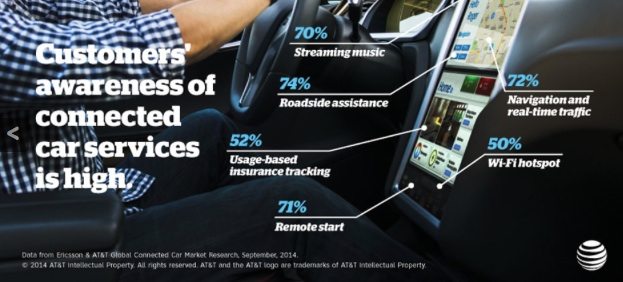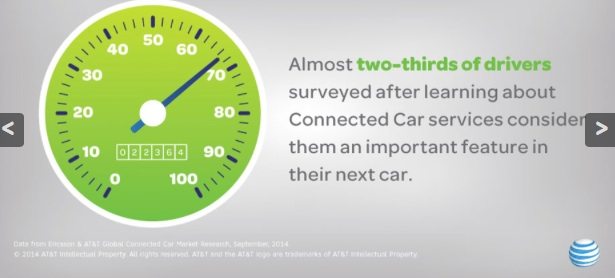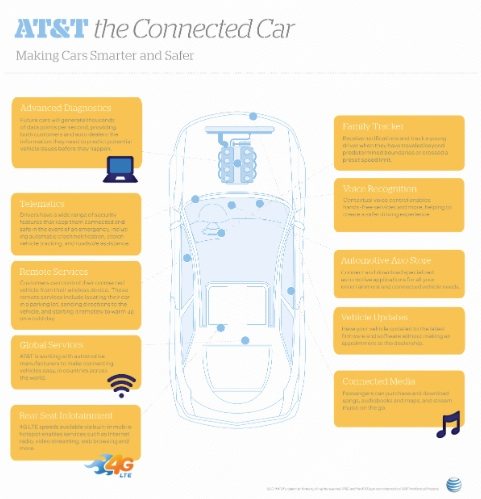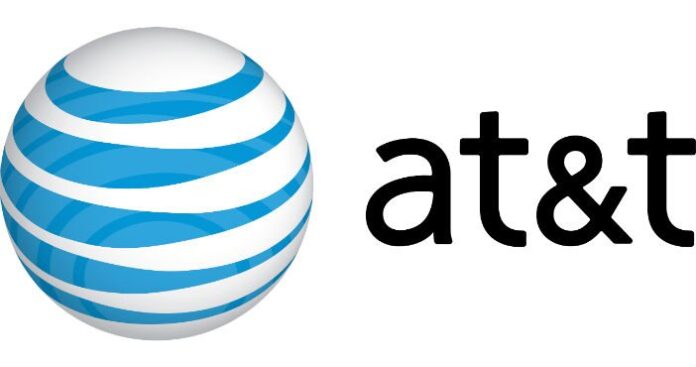The trend today is for everyone to talk about connected cars and it seems as though almost every telecom operator says they are playing here. But at what level are they doing connected cars and how much is aspirational for the future versus having a proven track record? In order to come to a determination you have to consider who is publicly sharing what they are doing in a way that shows a cohesive strategy and consistent achievements – such as AT&T.
Why is AT&T able to show this level of comprehensive connected car knowledge? At the highest level there are four reasons:
- Executive commitment
- Longevity in this space
- Partnerships
- Technology
Let’s consider each one of these separately:
Executive commitment
When I spoke with AT&T about their focus on connected cars, I was told that not only does this topic have chairman-level focus, it’s No. 1 on the strategic areas of focus for the organization.
Longevity
AT&T is not new to this topic. It could be considered telematics, “Internet of Things,” Machine-2-Machine (M2M), connected car or whichever term fits with the industry at the moment; but they’ve been working on these concepts for six years now. It looks like there have been a great deal of announcements seemingly overnight, but the reality is there has been years of work leading up to them. A sampling of some of the key OEM announcements in 2014 include
- Chevrolet partnership announcement
- Audi partnership announcement
- Tesla partnership announcement
- Volvo partnership announcement
Throughout 2014 there has been a consistent flow of OEMs partnering with AT&T to enable connected car functionality in their current and future models. In addition, they are also working to address the aftermarket for vehicles back to 1992 in order to enable diagnostics, Wi-Fi hotspot functionality and more. Hopefully we’ll be hearing from them in the near future on this topic.
Partnerships
Earlier this year AT&T announced AT&T Drive and the Drive Studio. The Studio is located in Atlanta in close proximity to the AT&T Foundry innovation center where connected home and consumer electronics innovation takes place. The idea is to integrate these activities with the connected car experience in order to drive safety, convenience and entertainment within the vehicle. By integrating the car, the home and the cloud you can take the intelligence in each of these closed environments and link them together to enable new connected life experiences.
Within the Connected Drive experience there are many ecosystem partners that work to enable an end-to-end solution. Some of the key participants are Accenture, Amdocs, Clear Channel’s iHeart Radio, Ericsson, Jasper Wireless, Synchronoss and VoiceBox. The ability for application developers to work in this facility to build directly on the Connected Drive platform further enhances the end-to-end solution offers.
All good marketers will tell you that you need to understand your customer through hands-on research as you develop products for the future. AT&T and Ericsson recently partnered to conduct a global connected car survey to do just that.
The survey was conducted in the U.S., Germany, Brazil, Japan and China. The respondents were spread equally across all regions, so no single region influenced the results. They began by defining a “connected car.” This was an important level to set as everyone likely has a different view or no idea at all what this might be. The key elements of this description included wireless Internet access, infotainment services, navigation services, location-based services, voice-controlled applications, Wi-Fi hot spot and the fact that there is no need for satellite or tethering to your smartphone.
The good news is that most drivers are aware of some of today’s connected car functionality already, more than 70% in most cases. Although these categories were basic things like streaming music, roadside assistance, navigation with real-time traffic and remote start functionality. The results were also extremely positive for drivers wanting to buy these services and delaying a purchase of a new car or switching automotive brands to get these services. I honestly struggle a bit with these results. I guess that’s because I have very specific ideas about what brand of car I drive and so do most of my friends, but I know there is a large percentage of the population who consider a car a transport from A to B and purchase based on price only. It feels to me there might be a disconnect here, although I do hope that we end up with a society that is that aware of and engaged in connected cars. 
AT&T also partners with the Redbull F1 racing team to ensure the data gathered from the vehicles during a race can be captured, analyzed and reacted to in real time. And of course it’s always fun to watch a video with fast cars in it. But seriously, this partnership shows the integration of the high-speed technology with big data requirements and to me must be providing a testing ground for concepts that can be included in a normal car in a scaled down fashion down the road.
Technology
AT&T provides worldwide connectivity for M2M devices via a software-based global SIM. Certification is pre-certified for over 600 operators in over 200 countries. Combined with their existing LTE deployment and developing worldwide LTE partnerships, the technology to support cars on the move continues to increase.
 As a result of having looked at the market from many different angles – telematics, connectivity, connected car/infotainment, diagnostics, etc. – AT&T’s view of the connected car is quite comprehensive in bringing together all of these categories and linking them to the Digital Life/Home functionality. To download a copy of this graphic to view more of the details, please click here.
As a result of having looked at the market from many different angles – telematics, connectivity, connected car/infotainment, diagnostics, etc. – AT&T’s view of the connected car is quite comprehensive in bringing together all of these categories and linking them to the Digital Life/Home functionality. To download a copy of this graphic to view more of the details, please click here.
By being able to provide an end-to-end solution and customization by individual OEM, they are increasing the ease of which OEM’s can work with telecom operators to partner on connected cars. I am a strong believer that this must happen for success. The operators have too much value to add beyond just connectivity when it comes to capturing and interpreting data that results in consumer offers. The OEMs can learn from these insights. Although many other global operators are forging down this path, I believe there is a model here that others might consider leveraging as they build programs in their respective markets.

